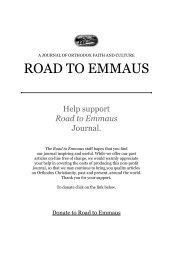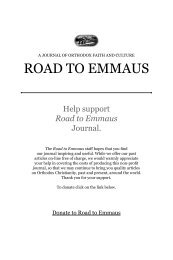RTE No 20 Interior - Road to Emmaus Journal
RTE No 20 Interior - Road to Emmaus Journal
RTE No 20 Interior - Road to Emmaus Journal
Create successful ePaper yourself
Turn your PDF publications into a flip-book with our unique Google optimized e-Paper software.
the as<strong>to</strong>nishing missionary journeys of the apostle andrewMother of God, are only found in apocryphal texts which have survived fromthis early era. This does not mean that we can consider these sources ascompletely true or valuable in themselves. Rather, we accept that some ofwhat is written in them can also exist in our holy Orthodox tradition. Wecannot declare that everything in them is wrong (such as the dormition ofthe Mother of God, when the Lord <strong>to</strong>ok her body and soul <strong>to</strong> heaven, themartyrdom of Apostle Andrew in Patras, the martyrdoms of Cyricus andJulitta, the tradition that the apostles “drew lots”). In fact, these condemnedsources may have some true his<strong>to</strong>rical facts mixed with legends and fairytales,and poisoned by heretical nonsense. The nonsense is what PopeGelasius condemned and what St. Gregory cleaned up. Another example ofthis borrowing is that Orthodox writers and church fathers have generallyaccepted the texts of Tertullian as a valuable his<strong>to</strong>rical source, although hisdoctrinal errors were also condemned by the Decretum.There are other sources of this tradition of St. Andrew in Africa as well:the hymnograpy of some Pre-Chalcedonian churches (e.g. Ethiopians andCopts) and the synaxarion of the Armenians which says that “Andrewpreached among the cannibals, or in the land of Barbarians (Enivarvaros),a place identical <strong>to</strong> Azania according Claudius P<strong>to</strong>lemy. As Orthodox, wecannot ignore this, because it is very likely that these sources come from theancient period of the unity of the Churches. If not heretical, they could be anOrthodox tradition, although this has not yet been confirmed.There are also non-Christian his<strong>to</strong>rical sources saying the same thing –Arab Islamic texts that say that the Holy Apostle Andrew preached in “theland of the cannibals, that was a land of the blacks.” These sources areimportant because they are not Christian, they come from the early traditionsand memories of the Arabic peoples.Finally we have <strong>to</strong> remember that not every apocryphon is a forgery or a legend.Orthodox theologians and fathers have taught us <strong>to</strong> classify as an apocryphonthose ancient Christian documents of unknown or unreliable validity.Some are heretical, some are forgeries, others are fantasies and romances.Some have interesting information that may even seem familiar as they incorporatereal pre-existing sources (which we no longer have copies of) that arethe basis of some of our Orthodox tradition, hymnography, and iconography.<strong>No</strong>t all apocryphal texts have been condemned by the Church. Of thosethat haven’t been condemned, our Christians fathers and theologians werefree <strong>to</strong> express their own opinions. In Orthodox tradition, no human opin-Georgian St. Andrew.37










